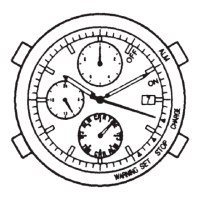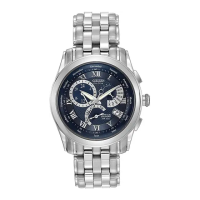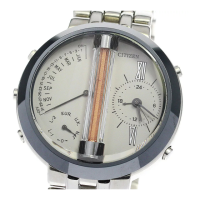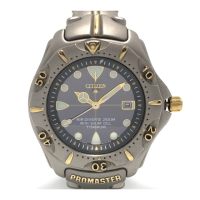
Do you have a question about the Citizen QUARTZ ECO-DRIVE CTZ B6796 and is the answer not in the manual?
| accuracy | Within ± 20sec per month at normal temperature range of (5°C/41°F to +35°C/95°F) |
|---|---|
| effective temperature range | -10°C ~ +60°C (14°F ~ 140°F) |
| quartz oscillation | 32, 768 Hz |
| quick start feature | Yes |
|---|---|
| overcharging prevention feature | Yes |
| insufficient recharging warning function feature | Yes |
| converter | Step motor |
|---|---|
| secondary battery used | Titanium lithium ion secondary battery (Parts number 295-34) |
| IC (Integrated Circuit) used | C/MOS-LSI-1 |
Identifies specific model and caliber numbers for the watch.
Indicates that this document serves as an instruction manual.
A specific code associated with the watch model.
Lists model numbers associated with diver's watches.
Describes the watch as a solar-powered analog quartz watch with a solar cell.
Explains the secondary battery and initial charging requirements.
Provides advice for comfortable and effective use of the solar watch.
Details the warning display when the watch is insufficiently charged.
Explains how the watch starts quickly after being exposed to light.
Describes the feature that prevents overcharging of the battery.
Elaborates on the two-second interval movement warning for low charge.
Explains the hitch movement indicating incorrect time setting.
Instructions for setting the correct time on the watch.
Instructions for setting the correct date on the watch.
Describes the cause and remedy for two-second interval movement.
Explains troubleshooting for the hitch movement indication.
Advice on keeping the watch charged, especially with long sleeves.
Warns against using non-specified batteries due to potential hazards.
Warns against recharging the watch in high temperatures.
Provides a table showing recharge times under different illuminance levels.
Explains how to use the register ring for measuring elapsed time.
Instructions on confirming the screw lock crown is tightly locked.
Lists essential checks to perform before diving.
Safety guidelines to follow while underwater.
Instructions for cleaning and caring for the watch after diving.
Explains how to interpret the chart for no decompression limits.
Provides an example to clarify the use of the decompression chart.
Advises on personal differences affecting decompression limits.
Details water resistance levels for various water-related uses.
Notes potential moisture build-up on the glass in certain conditions.
Advises against exposing the watch to extreme temperatures.
Warns against dropping or subjecting the watch to severe shock.
Advises keeping the watch away from strong magnetic sources.
Warns about the watch's sensitivity to static electricity.
Lists substances to avoid contact with to prevent damage.
Provides guidance on cleaning the watch and band.
Recommends periodic checks for long-term, trouble-free operation.
Details the watch's quartz oscillation frequency and accuracy.
Specifies the operating temperature range for the watch.
Lists extra features like quick start and warning functions.
Identifies the type of secondary battery and integrated circuit used.












